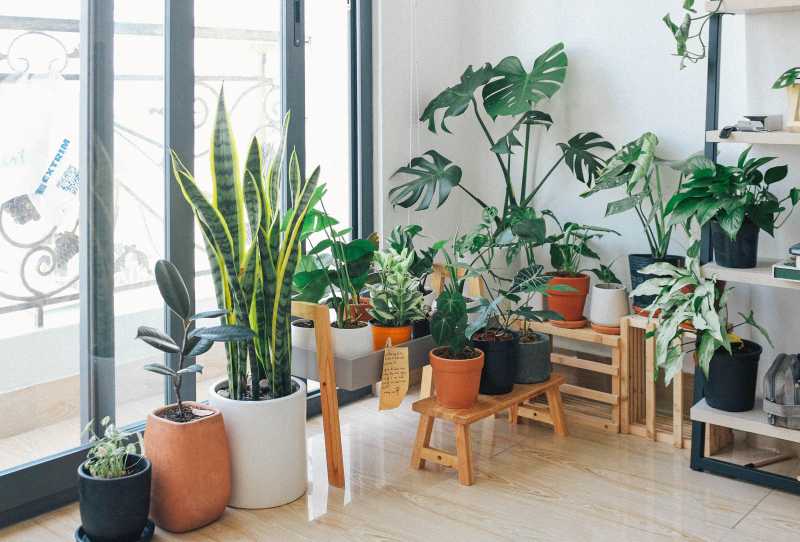Indoor plants have long been admired for their aesthetic appeal, but their ability to improve air quality is often overlooked. At Air Duct Cleaning, we understand the importance of clean, fresh air for your home or commercial property. Our focus on the impact of indoor plants on air quality aims to shed light on this often underappreciated benefit. Indoor plants can act as natural air purifiers, removing harmful toxins and improving the overall air quality. They can complement our professional air duct cleaning services, creating a healthier and more comfortable living or working environment. By integrating indoor plants into your space and maintaining clean air ducts, you can significantly enhance the quality of your indoor air. Discover the power of greenery in improving indoor air quality and promoting a healthier lifestyle.
Understanding the Role of Indoor Plants in Air Purification
Indoor plants have long been appreciated for their aesthetic appeal, but their role in improving air quality is often overlooked. They play a significant part in air purification, contributing to healthier indoor environments. This is particularly important considering that, according to the Environmental Protection Agency, indoor air can be two to five times more polluted than outdoor air.
Indoor plants act as natural air purifiers by absorbing harmful pollutants through their leaves and roots. This process, known as phytoremediation, involves the uptake of specific contaminants by plants, which are then metabolized or incorporated into plant tissues. NASA’s Clean Air Study, a landmark piece of research in this field, identified several houseplants that are particularly effective at removing common indoor pollutants such as benzene, formaldehyde, and trichloroethylene.
- The Spider Plant, for instance, is known for its ability to absorb carbon monoxide and xylene, a solvent used in the printing and rubber industries.
- The Peace Lily, another popular indoor plant, is effective at removing benzene and formaldehyde, common pollutants found in household cleaning products.
- The Snake Plant, also known as Mother-in-Law’s Tongue, is renowned for its ability to absorb formaldehyde, a common pollutant in toilet paper, tissues, and personal care products.
While indoor plants can significantly improve air quality, it’s important to note that they are not a standalone solution. They should be used in conjunction with other air purification strategies. For instance, regular air duct cleaning can help to remove dust, mold, and other pollutants that can accumulate in your HVAC system over time.
Moreover, understanding how often air ducts should be cleaned can help maintain optimal indoor air quality. Regular cleaning not only improves air quality but also enhances the efficiency of your HVAC system, leading to energy savings.
In addition to air duct cleaning, it’s also important to consider the role of ventilation in maintaining good indoor air quality. Proper ventilation helps to remove stale indoor air and replace it with fresh outdoor air. This can be particularly beneficial in high-humidity areas where mold growth can be a problem.
In conclusion, indoor plants play a vital role in air purification, helping to create healthier indoor environments. However, they should be seen as part of a broader strategy for maintaining good indoor air quality, which includes regular air duct cleaning and proper ventilation. By understanding and implementing these strategies, we can create indoor spaces that are not only aesthetically pleasing but also promote good health and well-being.
For more information on air duct cleaning and its benefits, visit our blog.
The Science Behind How Plants Improve Air Quality
Indoor plants are not just aesthetically pleasing; they also play a crucial role in improving air quality. This is due to the natural process of photosynthesis, where plants absorb carbon dioxide and release oxygen. But the benefits don’t stop there. Plants also have the ability to filter and purify the air, removing harmful toxins and improving overall air quality.
The process of photosynthesis is a fundamental aspect of plant biology. During this process, plants absorb carbon dioxide from the air. This gas is then used, along with water and light energy, to produce glucose, which provides the plant with energy. As a byproduct of this process, oxygen is released back into the air. This exchange of gases is a significant factor in improving air quality, as it increases oxygen levels and reduces carbon dioxide.
However, plants’ role in improving air quality extends beyond photosynthesis. They also have the ability to absorb other gases, including a variety of volatile organic compounds (VOCs). These compounds, which include substances like benzene, formaldehyde, and trichloroethylene, can be harmful to human health and are often found in indoor air due to off-gassing from furniture, carpets, and building materials.
Plants can absorb these harmful compounds through their leaves and roots. The toxins are then transported to the plant’s root zone, where they are broken down by microorganisms. This process, known as phytoremediation, effectively removes the toxins from the air, making it cleaner and safer to breathe.
In addition to filtering toxins, plants also help to regulate humidity levels. They release moisture into the air through a process known as transpiration. This can be particularly beneficial in indoor environments, which can often become dry due to heating or air conditioning systems. By increasing humidity levels, plants can help to create a more comfortable environment and reduce the risk of respiratory issues.
While all plants can contribute to improving air quality, some are particularly effective. These include species like the spider plant, English ivy, and peace lily, all of which have been shown to be particularly effective at removing VOCs from the air.
It’s important to note that while plants can significantly improve indoor air quality, they are not a substitute for proper ventilation and air duct cleaning. Regular cleaning of air ducts is essential to remove dust, mold, and other pollutants that can accumulate over time. For more information on this topic, you can visit our guide on how often air ducts should be cleaned.
In conclusion, the science behind how plants improve air quality is rooted in their natural processes of photosynthesis, phytoremediation, and transpiration. By absorbing carbon dioxide and other harmful compounds, and releasing oxygen and moisture into the air, plants can significantly improve the quality of indoor air. However, to ensure the best air quality, it’s also important to maintain good ventilation and regular air duct cleaning.
Top Indoor Plants for Enhancing Air Quality
Indoor plants not only add aesthetic appeal to your home or office but also play a significant role in enhancing air quality. They act as natural air purifiers, absorbing harmful pollutants and releasing fresh oxygen. This can significantly improve the indoor environment, making it healthier and more comfortable for inhabitants.
One of the most effective indoor plants for air purification is the Spider Plant (Chlorophytum comosum). This hardy plant is known for its ability to absorb formaldehyde, a common pollutant found in many household products. The Spider Plant is also easy to care for, making it a great choice for those new to indoor gardening.
The Snake Plant (Sansevieria trifasciata), also known as Mother-in-Law’s Tongue, is another excellent choice for improving indoor air quality. It is particularly effective at removing benzene and formaldehyde, common pollutants found in detergents and personal care products. The Snake Plant also releases oxygen at night, making it a great addition to bedrooms.
The Peace Lily (Spathiphyllum) is not only beautiful but also a powerful air purifier. It can remove a variety of pollutants, including benzene, formaldehyde, and trichloroethylene. However, it’s important to note that Peace Lilies are toxic if ingested, so they should be kept out of reach of children and pets.
The Boston Fern (Nephrolepis exaltata) is a popular indoor plant known for its air-purifying abilities. It is particularly effective at removing formaldehyde and xylene, a solvent used in the printing and rubber industries. Boston Ferns require a bit more care than some other indoor plants, but their air-purifying benefits make them worth the effort.
While indoor plants can significantly improve air quality, it’s important to remember that they are not a substitute for regular air duct cleaning. Over time, dust and pollutants can accumulate in your air ducts, reducing the efficiency of your HVAC system and potentially causing health problems. Regular cleaning can help ensure that your air ducts are functioning properly and providing clean, healthy air.
If you’re unsure whether your air ducts need cleaning, there are several indicators to observe. These include visible dust or mold in your air ducts, a musty odor when your HVAC system is running, and unexplained allergy symptoms. If you notice any of these signs, it may be time to schedule a professional air duct cleaning.
In conclusion, indoor plants can significantly enhance air quality by absorbing harmful pollutants and releasing fresh oxygen. However, they should be used in conjunction with regular air duct cleaning to ensure the best possible indoor air quality. By taking these steps, you can create a healthier, more comfortable indoor environment for yourself and your loved ones.
The Impact of Indoor Plants on Reducing Air Pollutants
Indoor plants are not just aesthetically pleasing, but they also play a significant role in improving air quality. They act as natural air purifiers, reducing the levels of harmful pollutants in the air. This is particularly beneficial in indoor environments where air circulation can be limited, and pollutants can accumulate over time.
One of the primary ways indoor plants improve air quality is through the process of photosynthesis. During this process, plants absorb carbon dioxide and release oxygen, thereby increasing the oxygen levels in the air. However, what is less known is that plants can also absorb other harmful pollutants present in the air.
A study by NASA found that certain indoor plants can remove up to 87% of air toxins in 24 hours. These toxins include benzene, formaldehyde, and trichloroethylene, which are commonly found in homes and offices due to the use of synthetic materials. By absorbing these toxins, indoor plants can significantly reduce their concentrations in the air, leading to cleaner and healthier indoor environments.
In addition to absorbing pollutants, indoor plants can also help to increase humidity levels. They release moisture into the air through a process called transpiration. This can be particularly beneficial in dry indoor environments, as increased humidity can help to reduce dust and other airborne particles, further improving air quality.
However, while indoor plants can contribute to cleaner air, they are not a substitute for proper ventilation and air cleaning. Regular air duct cleaning is crucial to ensure that air circulation is not hindered by dust and debris. Moreover, understanding how often air ducts should be cleaned can help maintain optimal indoor air quality.
It’s also worth noting that not all indoor plants are equally effective at reducing air pollutants. Some plants are more efficient at absorbing certain toxins than others. For instance, the spider plant is particularly effective at removing formaldehyde, while the snake plant is excellent at absorbing benzene. Therefore, it’s important to choose the right plants based on the specific needs of your indoor environment.
In conclusion, indoor plants can significantly improve air quality by reducing air pollutants and increasing humidity levels. However, they should be used in conjunction with regular air duct cleaning to ensure optimal air quality. By understanding the importance of air duct cleaning and choosing the right indoor plants, you can create a healthier and more comfortable indoor environment.
Health Benefits of Improved Air Quality Through Indoor Plants
Indoor plants have a significant impact on air quality, offering a plethora of health benefits. They act as natural air purifiers, removing harmful toxins and pollutants from the air we breathe. The presence of indoor plants can lead to improved air quality, which in turn, promotes better health and wellness.
One of the primary health benefits of improved air quality through indoor plants is the reduction of harmful pollutants. Indoor air can be two to five times more polluted than outdoor air, according to the Environmental Protection Agency. Indoor plants can absorb these harmful pollutants through their leaves and roots, converting them into harmless substances. This process, known as phytoremediation, can help reduce the risk of health issues such as asthma, allergies, and other respiratory conditions.
Indoor plants also release oxygen and absorb carbon dioxide during photosynthesis, improving the oxygen levels in your home. This can lead to improved concentration, increased energy levels, and better sleep quality. Furthermore, some indoor plants, such as the snake plant and the spider plant, release oxygen at night, making them ideal for bedrooms.
In addition to physical health benefits, indoor plants can also contribute to mental well-being. Studies have shown that the presence of indoor plants can reduce stress levels, improve mood, and enhance productivity. The act of caring for plants can also provide a sense of purpose and satisfaction, contributing to overall mental health.
While indoor plants can significantly improve air quality, it’s also important to maintain clean air ducts in your home. Regular air duct cleaning can help remove dust, allergens, and other pollutants that can accumulate over time, further improving indoor air quality.
However, it’s essential to understand how air duct cleaning works to ensure it’s done correctly and effectively. It’s also crucial to know how often to do air duct cleaning to maintain optimal air quality in your home.
In conclusion, indoor plants can significantly improve air quality, leading to numerous health benefits. They can reduce harmful pollutants, improve oxygen levels, and contribute to mental well-being. However, to maintain optimal air quality, it’s also crucial to regularly clean your air ducts. By combining these two strategies, you can create a healthier and more comfortable living environment.
How to Care for Your Indoor Plants for Optimal Air Quality
Indoor plants are not just aesthetically pleasing, they also play a significant role in improving the air quality in your home. They act as natural air purifiers, absorbing harmful pollutants and releasing oxygen. However, to ensure that your indoor plants are effectively improving air quality, it’s crucial to provide them with proper care and maintenance.
Firstly, it’s important to understand that different plants have different needs. Some plants require more sunlight than others, while some thrive in shady conditions. Therefore, it’s essential to research the specific needs of your plants and place them in appropriate locations in your home. For instance, succulents and cacti prefer bright, sunny spots, while ferns and ivy do well in lower light conditions.
Watering is another crucial aspect of plant care. Overwatering can lead to root rot, which not only harms the plant but can also lead to mold growth, negatively impacting air quality. On the other hand, underwatering can cause the plant to dry out and die. The frequency of watering depends on the type of plant, its size, and the environment. As a general rule, it’s best to water your plants when the top inch of soil feels dry to the touch.
Another important factor to consider is the quality of the soil. Plants need nutrient-rich soil to grow and thrive. Regularly adding organic compost or a slow-release fertilizer can help maintain the nutrient content of the soil. Additionally, it’s important to ensure that the soil is well-draining to prevent waterlogging.
Regularly cleaning the leaves of your plants can also improve their ability to purify air. Dust and grime can clog the pores of the leaves, reducing their ability to absorb carbon dioxide and release oxygen. You can clean the leaves by gently wiping them with a damp cloth or giving them a light shower.
Pruning is another important aspect of plant care. Regularly removing dead or yellowing leaves helps the plant direct its energy towards new growth. It also helps prevent the spread of disease and improves the overall health of the plant.
Lastly, it’s important to regularly check your plants for signs of pests or disease. Common indoor plant pests include spider mites, aphids, and mealybugs. If you notice any signs of pests or disease, it’s important to take action immediately to prevent the problem from spreading.
While indoor plants can significantly improve air quality, it’s also important to maintain the cleanliness of your home’s air ducts. Regular air duct cleaning can help remove dust, mold, and other pollutants that can negatively impact air quality. If you’re unsure whether your air ducts need cleaning, this guide can help you identify the signs.
In conclusion, proper care and maintenance of your indoor plants can significantly enhance their ability to improve air quality. By providing the right conditions and regular care, you can ensure that your indoor plants thrive and continue to purify the air in your home. For more information on improving indoor air quality, check out our blog.
The Future of Indoor Plants and Air Quality Improvement
Indoor plants have been a popular choice for home and office decor for many years. But beyond their aesthetic appeal, these green companions have a significant role in improving air quality. As we look towards the future, the importance of indoor plants in air quality improvement is expected to grow even more.
Scientific studies have proven that indoor plants can absorb harmful toxins from the air, especially in enclosed spaces. They can filter out common volatile organic compounds (VOCs) such as benzene, formaldehyde, and trichloroethylene. These compounds are often found in homes and offices, emitted by furniture, carpets, and electronic devices. By absorbing these toxins, indoor plants help to purify the air, making it healthier to breathe.
The future of indoor plants in air quality improvement lies in their increased use in homes, offices, and public spaces. As awareness about air pollution and its health impacts grows, more people are likely to turn to indoor plants as a natural, cost-effective solution. This trend is already evident, with a growing number of interior designers and architects incorporating indoor plants into their designs.
Moreover, technological advancements are expected to further enhance the air-purifying capabilities of indoor plants. Scientists are exploring ways to genetically modify plants to make them more effective at absorbing harmful pollutants. In the future, we may see indoor plants specifically engineered for air purification.
However, while indoor plants can significantly improve air quality, they are not a standalone solution. They should be used in conjunction with other air purification methods for maximum effectiveness. Regular air duct cleaning, for instance, is essential to maintain good indoor air quality. Over time, dust, mold, and other pollutants can accumulate in air ducts, negatively affecting air quality. Regular cleaning can help to remove these pollutants and improve the overall air quality.
It’s also important to understand how often air ducts should be cleaned. While the frequency can vary depending on several factors, including the number of occupants and pets, it’s generally recommended to have air ducts cleaned every three to five years.
In conclusion, the future of indoor plants in air quality improvement looks promising. As we continue to understand the benefits of these green companions, their use is likely to become more widespread. Coupled with other air purification methods like regular air duct cleaning, indoor plants can significantly contribute to creating healthier indoor environments.
In conclusion, indoor plants significantly contribute to improving air quality. They not only add aesthetic appeal to our homes and workspaces but also play a vital role in purifying the air we breathe. By absorbing harmful toxins and releasing oxygen, these green companions help in creating a healthier and more comfortable living environment. However, it’s essential to remember that plants alone cannot solve all air quality issues. They should be used in conjunction with other air purification methods for optimal results. The impact of indoor plants on air quality is a testament to the importance of integrating nature into our daily lives for overall well-being.





